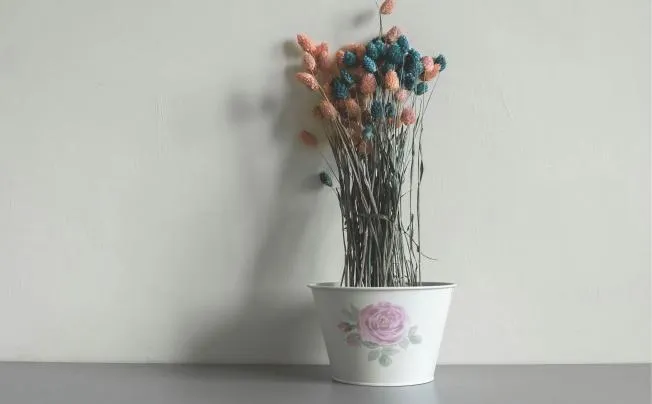How To Waterproof A Metal Planter?
When metal comes into touch with water, it can rust, which reduces the flower pot's lifespan. To make the metal flower pot more useful for gardening, it is crucial to waterproof it.
Waterproof tool preparation
1. Sandpaper: To make metal flower pots rougher and improve the adherence of waterproof paint or coating, sandpaper is used. Select moderately coarse and fine sandpaper. Too delicate sandpaper won't have a good polishing effect, and too coarse sandpaper might easily scratch the flower pot.
2. Brush: For applying waterproof coatings, paints, and sealants. Different materials require different brushes. For instance, to ensure equal application of waterproof paint, wool brushes are employed; for sealants, brushes with specialised glue guns are utilised.
3. Spray gun: Spray guns can increase efficiency and create a more uniform coating when applied to a large area; however, using one requires experience and mastery of the spraying distance and angle.
4. Stirring rod: Stir waterproof paint, coating, etc. to ensure uniform composition and waterproof effect.
Steps to waterproofing flower pots
Cleaning Flower Pots Made of Metal
To get rid of debris, dust, and oil, carefully wipe the flower pot's surface with water and a light detergent. After dipping the solution in a neutral detergent and adding the right amount of clean water, you can gently wipe it with a soft towel. To avoid scratching the flower pot's surface, stay away from using strong equipment like steel wool. Rinse well with fresh water after cleaning to get rid of any detergent residue. The flower pot can then be left to dry naturally in a well-ventilated area or dried with a fresh towel. A dry surface can enhance the waterproof effect and guarantee greater adhesion of later waterproof materials.
Examining and fixing
Examine the flower pot carefully for any holes, cracks, or other damage. To improve adhesion and make small fissures rougher, polish them with sandpaper. Next, use tools to compact and smooth the gaps after applying sealant evenly. Make sure the sealant fits tightly into the fissures. If the holes are bigger, cut the metal sheet to the proper size first, then use sandpaper to polish the hole and the metal sheet's edge, apply the welding agent, wrap the metal sheet over the hole, secure it with tools, and wait for the solvent to dry and solidify.
Initial therapy
Use a metal pretreatment chemical or primer to improve the adherence of waterproof materials. To increase the metal's resistance to rust and water damage, primer can provide a protective coating on its surface. Evenly coat the flower pot's surface with primer. You can use a spray gun or a brush. To guarantee complete covering without omissions or accumulation, use a brush in the proper order, from top to bottom and inside to outside. To ensure that the primer is sprayed uniformly, adjust the spray gun's distance and angle. As directed by the manufacturer, wait for the primer to dry after application.

Use materials that are waterproof
1. Waterproof paint: Use a brush or spray gun to apply waterproof paint that is appropriate for metal flower pots. Use a brush to apply evenly to prevent bubbles and leaking. To get consistent coating thickness while using a spray gun, modify the pressure and flow rate. Spray two to three coats in general, with the time between each application being as specified in the product's instructions.
2. Waterproof paint: Use a brush or roller to apply after evenly stirring. Apply the subsequent layer once the preceding layer has dried, adhering to the "thin coating and multiple coats" approach and keeping each layer's thickness between 0.5 and 1 mm. Typically, three to four layers are needed.
3. Sealant: Apply the sealant evenly to the flower pot's joints, corners, and other leaking areas using a glue gun. Then, fill in the spaces and smooth it out with tools to make sure the sealant completely fills in all of the spaces.
Curing and drying
Following application, set the flower pot in a dry, well-ventilated area and watch for the waterproof material to cure and dry as directed by the manufacturer. Touching the flower pot during this process is strictly prohibited in order to protect the coating and maintain the waterproof effect. Depending on the substance, the drying and curing process might take anything from a few hours to several days. To make sure the material is completely dried, wait patiently.
Waterproof effect inspection
Easy water splashing test
A straightforward water splashing test is carried out once the waterproof substance has dried and set entirely. To replicate regular watering, gradually pour a suitable volume of clean water into the flower pot. When pouring, pay close attention to the flower pot's exterior, paying particular attention to the joints, bottom and corners, to check for any water stains. Once the water has been poured, mark the area and do additional checks if water stains are discovered. The waterproof material can be reapplied if there is a slight amount of water seepage, which could indicate that the coating is somewhat weak; if there is a noticeable leak, the leaking area needs to be reprocessed.
Extended observation
Place the flower pot for a while, ideally one to two days, following the easy test. To prevent movement and collision, keep the flower pot in a steady location throughout this time. Check the flower container frequently to see if the soil inside is wet and if the outside has any water marks. The presence of water marks on the flower pot's outside suggests that the waterproofing is flawed, and the issue must be looked into and fixed. Plant growth will be impacted by internal water accumulation, which should be addressed promptly.

Care and maintenance tips
Precautions for daily use
In daily use, avoid sharp objects from scratching the surface of metal flower pots. Sharp objects can easily scratch the waterproof layer, exposing the metal and increasing the risk of rust. Prevent heavy objects from hitting the pot to avoid deformation of the pot body and cracking of the waterproof layer. Control the frequency and amount of watering to avoid stagnant water soaking the pot body for a long time, which will affect the waterproof effect and the health of the plant roots.
Regular inspection
Regular inspection and timely repair can extend the flower pot's service life. Check the flower pot's waterproof effect at least once a month, look for rust on the surface, see if the coating is worn, and look for cracks in the sealant at the corners and joints. If wear or damage is discovered, fix it right away. If the sealant is cracked, clean the gap and reapply glue.
Selected Blogs
-
What customization services are available for metalworking customization?
2024-12-12
-
What Is The Difference Between A Plant Container And A Raised Bed?
2024-04-23
-
Garden Screening & Fence Panels
2024-04-23
-
Gardening pot selection tips
2024-04-17
-
The function and collocation of horticultural fire pot
2024-04-17


